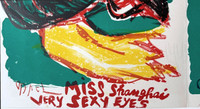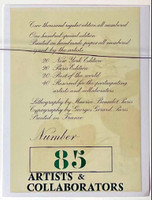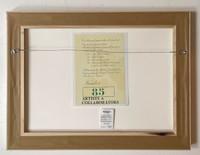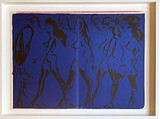
An Educated Collector is Our Best Client
In business for nearly two decades, we are a well established, popular contemporary art boutique specializing in expertly chosen, blue chip prints, multiples, uniques, books, ephemera and merchandise at different price points, with a focus on the secondary market. Please click on the "Contact Us" button at the bottom of this page for questions about any work, pricing and/or to arrange to visit our showroom/gallery - located in between Manhattan's Flatiron and Chelsea Flower Districts.
Karel Appel, Miss World First Class Pretty (Deluxe hand signed edition of the 1 Cent Life Portfolio, from the estate of artist Robert Indiana), 1964
CONTACT GALLERY FOR PRICE
Description
Karel Appel
Miss World First Class Pretty (Deluxe hand signed edition of the 1 Cent Life Portfolio, from the estate of artist Robert Indiana), 1964
Lithograph splayed across two sheets on wove paper (Hand signed by Karel Appel)
Pencil signed on the lower right front; numbered 85/100 on the portfolio colophon
Frame included
Floated and framed in a museum quality wood frame with UV plexiglass.
Measurements:
Frame:
20.25 x 27 x 1.25 inches
Print:
16 x 23 inches
This lithograph was part of the complete portfolio acquired from the estate of Pop Artist Robert Indiana, who also contributed a work to the portfolio. Documented prints from the hand signed edition of 100 rarely appear on the market. This is one of them. The work is pencil signed by Karel Appel on the front and all of the prints are unnumbered, as the complete portfolio is numbered on the colophon page - a copy of which is included for provenance.
(There was also an unsigned edition of 2000)
Chinese American artist and writer Walasse Ting, in collaboration with Sam Francis, assembled a group of the most significant Pop and Abstract Expressionist artists in America, including Andy Warhol, along with the European COBRA artists to create the definitive artistic portfolio of lithographs with accompanying text by Walasse Ting. The Deluxe edition, which features hand signed prints, was published in a limited edition of only 100. This is one of them. Of the 100, editions numbered 60-100, or 40 portfolios, were reserved exclusively for Artists & Collaborators. This hand signed Karel Appel lithograph is from the portfolio numbered 85 (Artists & Collaborators), which was acquired from the Estate and Collection of Robert Indiana, another one of the artists who contributed to the 1 Cent Life portfolio.
It is elegantly floated and framed in a museum frame with UV plexiglass with Optium museum plexiglass.
Signed examples of this portfolio with such fine provenance rarely appear on the marketplace. This is a true collectors item, from the most influential era in Pop Art history.
Published by E.W. Kornfeld, Germany, Written by Walasse Ting, Edited by Sam Francis
Provenance: Acquired from original, complete 1 Cent Life Portfolio, # 85/100 (Artists & Collaborators) from the Estate and Collection of Robert Indiana
More about the Signed (Deluxe) Edition of 1 Cent Life portfolio:
In 1962, the Chinese-American artist Walasse Ting shared his dream project with painter Sam Francis: to create an anthology of his poetry illustrated by leading artists of their time. Over the next two years, Ting and Francis recruited leading Abstract Expressionists and Pop artists—Andy Warhol, Joan Mitchell, Robert Rauschenberg, Robert Indiana, James Rosenquist, Mel Ramos, Claes Oldenburg and Roy Lichtenstein, among them, along with the European COBRA artists, like Asger Jorn, Karel Appel and Pierre Alechinsky —to create prints for their collaborative publication, which they playfully titled 1¢ Life. Published in 1964 by E. W. Kornfeld in Switzerland in an edition of 2,000 books, 1¢ Life features 62 color lithographs by a total of 28 iconic artists, including colorful lips by Warhol, abstract splatters by Mitchell, and cartoon girls by Lichtenstein. The accompanying many of these Pop Art prints are the poems of Walasse Ting - racy and avant garde for the early 1960s. The lithography was executed by Maurice Beaudet, of Paris. Complete examples of 1¢ Life can be found in the permanent collections of the Metropolitan Museum of Art, the British Museum and many other public and private institutions around the globe. Today, 1 Cent Life is considered one of the best artist's books ever created- coming out of one of the most influential decades in modern art.
Apart from the familiar regular edition of 2000, only 100 of these lithographic portfolios were hand signed by the artists (the Robert Indiana being stamped with his official stamp), and of those only 40 were reserved for Artists and Collaborators, numbered 60 through 100. (The present work, being # 85/100)
Most lithographs are printed on two separate pages. This famed portfolio was produced and assembled by Chinese-American-European artist Walasse Ting in conjunction with American artist Sam Francis, Swiss publisher E.W. Kornfeld, and French printer Maurice Beaudet - a truly global endeavor. The portfolio, featuring some of the most recognizable lithographs of the era, was the result of an unprecedented, ambitious international collaboration between American Pop Artists of the Sixties and the European COBRA artists.
About Karel Appel:
Qualifying Karel Appel (b.1921, Amsterdam- d.2006, Zurich) as one of the internationally best renowned Dutch artists of the 20th century may be misleading, as he left the Netherlands already in 1950 for good to realize his long career predominantly between Paris and New York. In this perspective, he may be considered as truly international, not belonging to one particular country in the first place.
Appel was one of the founders of CoBrA. Then Michel Tapié, whom he had met in Paris through Hugo Claus, featured him in his Art Autre exhibition. Tapié, then, introduced him to Martha Jackson, who, starting with an exhibition in 1954 would become his New York gallery for almost twenty years. Also, Willem Sandberg, the then director of the Stedelijk Museum Amsterdam, was an early supporter: He sent his friend, James Johnson Sweeney, director of the Guggenheim Museum on visit in Paris, to Appel’s studio in the Rue de Santeuil. All this made Karel Appel in his early 30ies already a name in the international avant-garde of the 1950ies. His expressionist and intuitive approach to painting was fitting perfectly well within this context. However, as abstraction had almost become an orthodoxy, his painting style, not being entirely abstract, set him apart. The primordial example for the intermediate position between abstraction and figuration was of course provided by Picasso. Appel appropriated this in his own, very peculiar manner, oscillating between both, and became in turn a reference for younger artists, who opposed abstraction but wouldn’t return to figuration for that matter.
Appel once said that, while Amsterdam had been the city of his youth, Paris was the city of his development – what he had learned in Paris was crucial. So, it would seem only natural, that after a long and entirely international career, he is buried at Père-Lachaise in Paris. However, in the course of the globalization of art, this very peculiar role of its historical capital for Appels oeuvre had fallen somewhat in oblivion, but in recent years, several important exhibitions in Paris, The Hague and Washington have contributed to rectify the record.
Courtesy of Almine Rech













![Sam Francis, Untitled from the Deluxe [signed] edition of the 1 Cent Life Portfolio (hand signed twice, #85/100, acquired from the Estate of Robert Indiana), 1964 Sam Francis, Untitled from the Deluxe [signed] edition of the 1 Cent Life Portfolio (hand signed twice, #85/100, acquired from the Estate of Robert Indiana), 1964](https://cdn11.bigcommerce.com/s-n5q4qk/images/stencil/160w/products/3160/13475/unnamed-5__69194.1694555439.jpg?c=2)

